Students must practice these Maths 1A Important Questions TS Inter 1st Year Maths 1A Functions Important Questions Very Short Answer Type to help strengthen their preparations for exams.
TS Inter 1st Year Maths 1A Functions Important Questions Very Short Answer Type
Question 1.
If the function f is defined by

then find the 2x +1, x < -3 values if exist of f(4), f(2.5), f(- 2), f(- 4), f(0), f(- 7). [Mar 14]
Answer:
(i) f(4) For x > 3, f(x) = 3x – 2
f(4) = 3 (4) – 2 = 12 – 2 = 10
(ii) f(2.5) is not defined.
(iii) f(-2)
For – 2 ≤ x ≤ 2, f(x) = x2 – 2
f(- 2) = (- 2)2 – 2 = 4 – 2 = 2
(iv) f(-4)
For x < – 3, f(x) = 2x + 1
f(- 4) = 2(- 4) + 1 = – 8 + 1 = – 7
(v) f(0)
For – 2 ≤ x ≤ 2, f(x) = x2 – 2
f(0) = 02 – 2 = – 2
(vi) f(- 7)
For x < – 3, f(x) = 2x + 1
f(- 7) = 2 (- 7) + 1 = – 14 + 1 = – 13
![]()
If the function f is defined by

then find the values of
(i) f(3)
(ii) f(0)
(iii) f(-1.5)
(iv) f(2) + f(-2)
(v) f(- 5).
Answer:
(i) 5
(ii) 2
(iii) – 2.5
(iv) 1
(v) not defined
Question 2.
If A = \(\left\{0, \frac{\pi}{6}, \frac{\pi}{4}, \frac{\pi}{3}, \frac{\pi}{2}\right\}\) and f: A → B is a surjection defined by f(x) = cos x then find B. [Mar. (TS) 17, 16 (AP), 11 May 15 (AP), 15 (TS), 11]
Answer:
Given A = \(\left\{0, \frac{\pi}{6}, \frac{\pi}{4}, \frac{\pi}{3}, \frac{\pi}{2}\right\}\)
f(x) = cos x
Since f: A → B is a surjection then f(A) = B
f(0) = cos 0 = 1
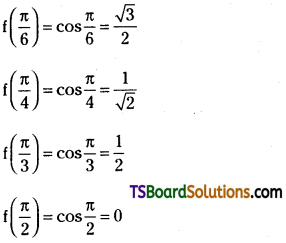
∴ B = Range . f(A) = {1, \(\frac{\sqrt{3}}{2}, \frac{1}{\sqrt{2}}, \frac{1}{2}\), o}
If A = {- 2, – 1, 0, 1, 2} and f: A → B is a surjection defined by f(x) = x2 + x + 1, then find B. [Mar. (AP) 19, 17] [Mar 16 (TS): May 14, 10]
Answer:
{3, 1, 7}
If A = {1, 2, 3, 4} and f: A → R is a function defined by f(x) = \(\frac{x^2-x+1}{x+1}\), then find the range of f.
Answer:
\(\left\{1, \frac{1}{2}, \frac{7}{4}, \frac{13}{5}\right\}\)
Question 3.
Determine whether the function f: R → R defined by

is an injection or a surjection or a bijection.
Answer:
Given f: R → R

If x = 3 > 2 then f(3) = 3
If x = 1 <2 then f(1) = 5(1) – 2 = 5 – 2 = 3
∴ 1 and 3 have same f image,
∴ f is not an injection.
If y ∈ R (co-domain) then y = x
x = y
then f (x) = x
f(x) = y
If y ∈ R (co-domain) then y = 5x – 2
y + 2 = 5x
x = \(\frac{y+2}{5}\)
then f (x) = 5x – 2

= y + 2 – 2 = y
∴ f is a surjection since f is not an injection then it is not a bijection.
![]()
Question 4.
If f: R → R, g : R → R are defined by f(x) = 4x – 1 and g(x) = x2 + 2 then find [May 09. Mar. 05, 04]
(i)(gof) (x)
(ii) (gof) \(\left(\frac{a+1}{4}\right)\)
(iii) (fof) (x)
(iv) [go (fof)] (0)
Answer:
Given f: R → R, g: R → R
f(x) = 4x – 1 and g(x) = x2 + 2
(i) (gof) (x) = g [f(x)] = g[4x – 1]
= (4x – 1)2 + 2
= 16x2 + 1 – 8x + 2
= 16x2 – 8x + 3
(ii) (gof) \(\left(\frac{a+1}{4}\right)\) = g \(\left[\mathrm{f}\left(\frac{\mathrm{a}+1}{4}\right)\right]\)
= g\(\left[4\left(\frac{a+1}{4}\right)-1\right]\)
= g[a + 1 – 1 ]
= g(a) = a2 + 2
(iii) (fof) (x) = f [f(x)] = f[4x – 1]
= 4 (4x – 1) – 1
= 16x – 4 – 1
= 16x – 5
(iv) [go (fof)] (0)
Now (fof) (0) = f[f(0)] = f[4(0) – 1] = f(- 1)
= 4( – 1) – 1 = – 4 – 1 = – 5
[go (fof)] (0) = go [(fof)(0)]
= g [- 5] = (- 5)2 + 2
= 25 + 2 = 27
Question 5.
If f: Q → Q is defined by f(x) = 5x + 4 for all x ∈ Q, show that ‘f is a bijection and find f-1. [Mar. 17 (TS). 16 (AP)]
Answer:
Given f: Q → Q, f(x) = 5x + 4, ∀ x ∈ Q
Let a1, a2 ∈ Q
f(a1) = f(a2)
5a1 + 4 = 5a2 + 4
5a1 = 5a2
a1 = a2
∴ f: Q → Q is an one – one function.
Let y ∈ Q (co-domain) then y = 5x + 4
y – 4 = 5x
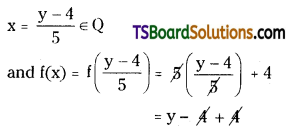
f(x) = y
∴ f: Q → Q is an onto function.
∴ f: Q → Q is a bijection.
∴ f-1: Q → Q is a bijection.
Question 6.
If f : R → R, g : R → R are defined by f(x) = 3x – 1, g(x) = x2 + 1, then find (fog) (2). [Mar. 18 (AP) May 13; Mar 13]
Answer:
Given f: R → R and g : R → R defined by
f(x) = 3x – 1 ; g(x) = x2 + 1
(fog) (2) = f[g(2)] = f(22 + 1)
= f(5) = 3(5) – 1 = 14
![]()
Question 7.
If f(x) = \(\frac{1}{x}\), g (x) = √x for all x ∈ (0, ∞), x then find (gof) (x).
Answer:
Given
f(x) = \(\frac{1}{x}\), g(x) = √x ∀ x ∈ (0, ∞)
Now (gof) (x) = g[f(x)] = g \(\left[\frac{1}{x}\right]\) = \(\sqrt{\frac{1}{x}}=\frac{1}{\sqrt{x}}\)
Question 8.
If f(x) = 2x – 1, g(x) = \(\frac{x+1}{2}\) for all x ∈ R, then find (gof) (x). [Mar 19 (AP); Sep 92]
Answer:
Given f(x) = 2x – 1, g(x) \(\frac{x+1}{2}\) ∀ x ∈ R
Now (gof) (x) = g[f(x)] = g(2x – 1)
= \(\frac{2 \mathrm{x}-1+1}{2}\) = \(\frac{2 x}{2x}\) = x
Question 9.
If f(x) = 2, g(x) = x2, h(x) = 2x for all x ∈ R, then find [fo(goh)] (x). [Mar. 17 (TS); July 01]
Answer:
Given f(x) = 2, g(x) = x2, h(x) = 2x ∀ x ∈ R.
Now (goh) (x) = g[h(x)] = g[2x] = (2x)2 = 4x2
[fo(goh)](x) = f[(goh) (x)] = f[4x2] = 2
Question 10.
Find the inverse function of f(x) = ax + b, (a ≠ 0); a, b ∈ R [Mar. 18 (TS); Mar. 13]
Answer:
Given, a, b ∈ R, f: R → R and
f(x) = ax + b
Let y = f(x) = ax + b
y = f(x) ⇒ x = f -1 (y) …………….. (1)
y = ax + b ⇒ ax = y – b ⇒ x = \(\frac{\mathrm{y}-\mathrm{b}}{\mathrm{a}}\) ……………… (2)
From (1) and (2)
f-1(y) = \(\frac{y-b}{a}\) ⇒ f-1(x) = \(\frac{x-b}{a}\)
If f: Q → Q is defined by f(x) = 5x + 4, for all x ∈ Q, find f-1. [Mar. 12, 10]
Answer:
\(\frac{x-4}{5}\)
Question 11.
Find the inverse function of f(x) = 5x [Mar. 15 (AP); Mar. ’11’, 06]
Answer:
Given f(x) = 5x
Let y = f(x) = 5x
y = f(x) ⇒ x = f-1(y) …………………. (1)
y = 5x ⇒ x = log5y ……………………. (2)
From (1) and (2),
f-1(y) = log5y ⇒ f-1 (x) = log5x
Question 12.
If f: R → R, g: R → R defined by f(x) = 3x – 2, g(x) = x2 + 1, then find (i) (gof-1) (2) (ii) (gof) (x – 1). [Mar. 08; May 06]
Answer:
Given f: R → R, g: R → R, f(x) = 3x – 2, g(x) = x2 – 1
Let y = f(x) = 3x – 2
y = f(x) ⇒ x = f-1 ……………. (1)
y = 3x – 2 ⇒ y + 2 = 3x
x = \(\frac{\mathrm{y}+2}{3}\) ………………….. (2)
From (1) & (2)
f-1(y) = \(\frac{\mathrm{y}+2}{3}\)
⇒ f-1 (x) = \(\frac{\mathrm{x}+2}{3}\)
![]()
(i) (gof-1) (2)
= g[f-1 (2)]
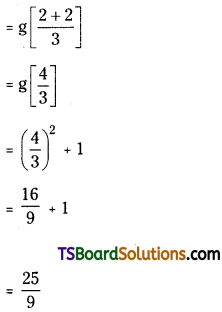
(ii) (gof) (x – 1)
= g[f(x -1)]
= g[3(x – 1) – 2]
= g[3x – 3 – 2]
= g(3x – 5)
= (3x – 5)2 + 1
= 9x2 + 25 – 30x + 1
= 9x2 – 30x + 26
Question 13.
If f(x) = \(\frac{x+1}{x-1}\) (x ≠ ± 1), then find (fofof) (x) [Mar. 05]
Answer:
Given f(x) = \(\frac{x+1}{x-1}\) (x ≠ ± 1)
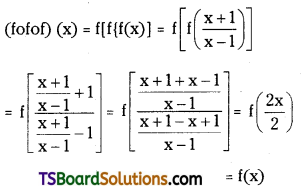
If f(x) = \(\) (x ≠ ± 1), then find (fofofof) (x)
Answer:
x
Question 14.
Find the domain of the real valued function f(x) = \(\sqrt{a^2-x^2}\) [June 04]
Answer:
Given f(x) = \(\sqrt{a^2-x^2}\) ∈ R
⇒ a2 – x2 ≥ 0
⇒ x2 – a2 ≤ 0
⇒ (x + a) (x – a) ≤ 0
– a ≤ x ≤ a

⇒ x ∈ [-a, a]
∴ Domain of ‘f is [-a, a]
Find the domain of the real valued function f(x) = \(\sqrt{16-x^2}\).
Answer:
[- 4, 4]
Find the domain of the real valued function f(x) = \(\sqrt{9-x^2}\).
Answer:
[-3, 3]
![]()
Question 15.
Find the domain of the real valued function
f(x) = \(\frac{1}{\left(x^2-1\right)(x+3)}\). [May 14, 93; Mar. 14]
Answer:
Given f(x) = \(\frac{1}{\left(x^2-1\right)(x+3)}\)
f(x) = \(\frac{1}{\left(x^2-1\right)(x+3)}\) ∈ R
⇒ (x2 – 1) (x + 3) ≠ 0
x2 – 1 ≠ 0, x + 3 ≠ 0
x2 ≠ 1, x ≠ – 3
x ≠ ± 1
∴ x ≠ -3, -1, 1
∴ Domain of ‘f is R – {-3, -1, 1}
Find the domain of the real valued function f(x) = \(\frac{1}{6 x-x^2-5}\).
Answer:
R – {1, 5}
Find the domain of the real valued function f(x) = \(\frac{2 x^2-5 x+7}{(x-1)(x-2)(x-3)}\)
Answer:
R- {1, 2, 3}
Question 16.
Find the domain of the real valued function f(x) = \(\sqrt{4 x-x^2}\). [May 12, 10] [Mar; 18 (TS)]
Answer:
Given, f(x) = \(\sqrt{4 x-x^2}\) ∈ R
⇒ x(4 – x) ≥ 0

⇒ x(4 – x) ≥ 0
⇒ x(x-4) ≤ 0
⇒ (x – 0) (x – 4) ≤ 0
⇒ 0 ≤ x ≤ 4
∴ Domain of ‘f’ is [0, 4].
Question 17.
Find the domain of the real valued function f(x) = \(\frac{1}{\sqrt{1-x^2}}\)
Answer:
Given f(x) = \(\frac{1}{\sqrt{1-x^2}}\) ∈ R

⇔ 1 – x2 > 0 “
⇔ (1 + x) (1 – x) > 0
⇔ x ∈ (-1, 1)
∴ Domain of T = {x/x ∈ (-1, 1)}
Question 18.
Find the domain of the real valued function f(x) = \(\sqrt{\mathbf{x}^2-25}\) [May 15 (AP); Mar. 12]
Answer:
Given f(x) = \(\sqrt{x^2-25}\) ∈ R
⇒ x2 – 25 ≥ 0
⇒ (x + 5) (x – 5) ≥ 0
⇒ x < -5 or x > 5
⇒ x ∈ (- α, -5] ∪ [5, α)
∴ Domain of T is (-α, -5] ∪ [5, α).

![]()
Question 19.
Find the domain of the real valued function f(x) = log (x2 – 4x + 3) [Mar. 16 (TS), 10, ‘08 ; May 11, 07]
Answer:
Given f(x) = log (x2 – 4x + 3) ∈ R
⇒ x2 – 4x + 3 > 0
⇒ x2 – 3x – x + 3 > 0
⇒ x (x – 3) – 1 (x – 3) > 0
⇒ (x – 1) (x – 3) > 0
⇒ x < 1 or x > 3
⇒ x ∈ (- α, 1) ∪ (3, α)

Question 20.
Find the domain of the real valued function f(x) = \(\frac{\sqrt{3+x}+\sqrt{3-x}}{x}\)
Answer:
Given f(x) = \(\frac{\sqrt{3+x}+\sqrt{3-x}}{x}\) ∈ R
⇒ 3 + x ≥ 0 and 3 – x ≥ 0, x ≠ 0
x ≥ – 3 and 3 ≥ x, x ≠ 0, x ≤ 3
x ∈ [- 3, ∝) ∩ (-∝, 3) – {0}
⇒ x ∈ [- 3, 3] – {0}
(or)
⇒ x ∈ [- 3, 0) ∪ (0, 3]
∴ Domain of ‘f is [- 3, 3] – {0}

Find the domain of the real valued function f(x) = \(\frac{\sqrt{2+x}+\sqrt{2-x}}{x}\).
Answer:
[- 2, 0) ∪ (0, 2]
Question 21.
Find the range of the reed valued function, log |4 – x2|.
Answer:
Let y = f(x) = log |4 – x2|
f(x) ∈ R ⇒ 4 – x2 ≠ 0
x2 ≠ 4 ⇒ x ≠ ± 2
∴ Domain of ‘f is R – {- 2, 2}
∴ y = loge |4 – x2|
|4 – x2| = ey
⇒ ey > 0, ∀ y ∈ R
∴ Range of T is R.
Question 22.
Find the range of the real valued function. \(\frac{x^2-4}{x-2}\) [May 03, 97]
Answer:
Let y = f(x) = \(\frac{x^2-4}{x-2}\)
f(x) ∈ R ⇒ x – 2 ≠ 0 ⇒ x ≠ 2
∴ Domain of ‘f is R – {2}
Let y = \(\frac{x^2-4}{x-2}\), if x ≠ 2 then y = x + 2
If x = 2, then y = 2 + 2 = 4
y is not defined at x = 2, then y cannot be equal to 4.
∴ Range of T is R – {4}.
![]()
Question 23.
Find the domain and range of the function f(x) = \(\frac{x}{2-3 x}\)
Answer:
Given f(x) = \(\frac{x}{2-3 x}\) ∈ R
⇒ 2 – 3x ≠ 0
⇒ 2 ≠ 3x
⇒ x ≠ \(\frac{2}{3}\)
∴ Domain of ‘f’ is R – \(\left\{\frac{2}{3}\right\}\)
Let y = f(x) = \(\frac{x}{2-3 x}\)
∴ y = \(\frac{x}{2-3 x}\)
2y – 3xy = x ⇒ 2y = x + 3x ⇒ 2y = x(1 + 3y)
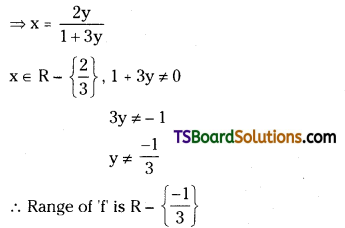
Question 24.
If f = {(4, 5), (5, 6), (6, – 4)} and g = {(4, -4), (6, 5), (8, 5)}, then find
(i) f + 4
(ii) fg
(iii) √f
(iv) f2.
Answer:
(i) f + 4
Domain of f + 4 = A = {4, 5, 6}
(f + 4) (x) = f(x) + 4
(f + 4) (4) = f(4) + 4 = 5 + 4 = 9
(f + 4) (5) = f(5) + 4 = 6 + 4= 10
(f + 4) (6) = f(6) + 4 = -4 + 4 = 0
∴ f + 4 = {(4, 9), (5, 10), (6, 0)}
(ii) fg
Domain of fg = A ∩ B = {4, 6}
(fg) (x) = f(x) . g(x)
(fg) (4) = f(4) . g(4) = 5(-4) = -20
(fg) (6) = f(6) . g(6) = (-4) (5) = -20
∴ fg = {(4, -20), (6, – 20)}
(iii) √f
Domain of √f = {4, 5, 6} = A
√f (x) = √f(x)
√f(4) = √f(4) = √5
√f (5) = √f(5) = √6
√f (6) = √f(6) = √-4 (does not exist)
∴ √f = {(4, √5), (5, √6)}
(iv) f2
Domain of f2 = A = {4, 5, 6}
f2(x) = [f(x)]2
f2(4) = [f(4)]2 = (5)2 = 25
f2(5) = [f(5)]2 = (6)2 = 36
f2(6) = [f(6)]2 = (- 4)2 = 16
∴ f2 = {(4, 25), (5, 36), (6, 16)}
![]()
If f = {(1, 2), (2, -3), (3, -1)}, then find
(i) 2f [Mar. 12; 94, 90; May 94]
(ii) 2 + f [Mar. 12; May 08]
(iii) f2 [Mar. 08, May. 95, 90]
(iv) √f
Answer:
(i) {(1, 4), (2, -6), (3, -2)}
(ii) {(1, 4), (2, -1), (3, 1)}
(iii) {(1, 4), (2, 9), (3, 1)}
(iv) {(1, √2)}